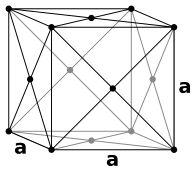Slip (materials science)

In
An external force makes parts of the
Slip systems
Face centered cubic crystals


Slip in
Given the permutations of the slip plane types and direction types, fcc crystals have 12 slip systems.[3] In the fcc lattice, the norm of the Burgers vector, b, can be calculated using the following equation:[4]
Where a is the lattice constant of the unit cell.
Body centered cubic crystals


Slip in
Some bcc materials (e.g. α-Fe) can contain up to 48 slip systems. There are six slip planes of type {110}, each with two <111> directions (12 systems). There are 24 {123} and 12 {112} planes each with one <111> direction (36 systems, for a total of 48). Although the number of possible slip systems is much higher in bcc crystals than fcc crystals, the ductility is not necessarily higher due to increased lattice friction stresses.[3] While the {123} and {112} planes are not exactly identical in activation energy to {110}, they are so close in energy that for all intents and purposes they can be treated as identical. In the diagram on the right the specific slip plane and direction are (110) and [111], respectively.[4]
Hexagonal close packed crystals
Slip in
Cadmium, zinc, magnesium, titanium, and beryllium have a slip plane at {0001} and a slip direction of <1120>. This creates a total of three slip systems, depending on orientation. Other combinations are also possible.[7]
There are two types of dislocations in crystals that can induce slip - edge dislocations and screw dislocations. Edge dislocations have the direction of the Burgers vector perpendicular to the dislocation line, while screw dislocations have the direction of the Burgers vector parallel to the dislocation line. The type of dislocations generated largely depends on the direction of the applied stress, temperature, and other factors. Screw dislocations can easily
Slip band

Formation of slip bands indicates a concentrated unidirectional slip on certain planes causing a stress concentration. Typically, slip bands induce surface steps (i.e. roughness due
Formation of slip bands under cyclic conditions is addressed as
Identification of slip activity
The main methods to identify the active slip system involve either slip trace analysis of single crystals[13][14] or polycrystals,[15][8] using diffraction techniques such as neutron diffraction[16] and high angular resolution electron backscatter diffraction elastic strain analysis,[17] or Transmission electron microscopy diffraction imaging of dislocations.[18]
In slip trace analysis, only the slip plane is measured, and the slip direction is inferred. In zirconium, for example, this enables the identification of slip activity on a basal, prism, or 1st/2nd order pyramidal plane. In the case of a 1st-order pyramidal plane trace, the slip could be in either 〈𝑎〉 or 〈𝑐 + 𝑎〉 directions; slip trace analysis cannot discriminate between these.[5]
Diffraction methods cannot generally resolve the slip plane of a residual dislocation. For example, in Zr, the screw components of 〈𝑎〉 dislocations could slip on prismatic, basal, or 1st-order pyramidal planes. Similarly, 〈𝑐 + 𝑎〉 screw dislocations could slip on either 1st or 2nd order pyramidal planes.[5]
See also
- Miller indices
- Persistent slip bands
References
- ^ Jastrzebski, D. Nature and Properties of Engineering Materials (Wiley International ed.).
- ^ ISBN 0-7506-4681-0
- ^ OCLC 300921090.
- ^ a b c d Van Vliet, Krystyn J. (2006); "3.032 Mechanical Behavior of Materials" Archived 2009-09-17 at the Wayback Machine
- ^ )
- ISSN 1359-6454.
- ISBN 0-471-73696-1
- ^ S2CID 251783802.
- ISBN 978-0-08-098204-5, retrieved 2022-10-04
- ISSN 0142-1123.
- S2CID 96586802.
- ISSN 0001-6160.
- .
- hdl:10044/1/31552.
- S2CID 199405954.
- S2CID 136620892.
- .
- S2CID 137662799.
- hdl:10044/1/25966.
- PMID 26997901.
External links
- An online tutorial on slip, explained on DoITPoMS


